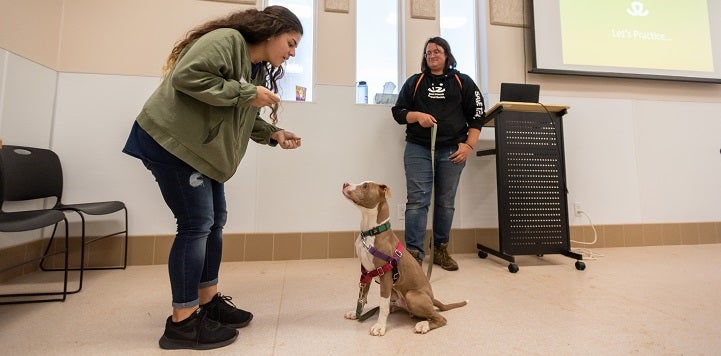
Innovative Ways to Work with At-Risk Dogs Town Hall
All dogs, big and small, deserve a safe place to call home. But dogs with challenging behaviors often need a little extra help and out-of-the-box thinking to move them toward adoption. During this town hall, Best Friends staff members shared a pilot program they created and are using at Best Friends Animal Sanctuary to help the most challenging dogs enjoy life and develop positive relationships with humans. They introduced techniques to help at-risk dogs cope, some of which you can emulate in a shelter environment. You'll hear about the non-traditional use of traditional tools and get the resources you need to help your agency’s challenging dogs progress safely.
Moderator: Bethany Heins - Director of Strategy and Network Operations, Best Friends Animal Society
Panelists:
- Michelle Logan - Director of National Shelter Embed Programming, Best Friends Animal Society
- Tierney Sain - National Mentorship Program Specialist, Best Friends Animal Society
Presentation
- Start Presentation - 3:28
- Panelist Introductions - 5:49
- Leashing Techniques (modified leashes and two-leash setup) – 7:25
- Muzzling for Dogs - 14:52
- Discussion on Muzzling Technique No. 1 Video - 15:14
- Muzzling Technique No. 2 Video - 20:15
- Muzzling Technique No. 3 Video - 21:40
- Combining Techniques - 24:38
- Safely Vaccinate Dog without Muzzle - 25:24
- Safely Feed / Enrichment Ideas - 25:55
- Discussion on Feeding Video - 28:31
- Balloon Enrichment Video - 29:19
- Crate Techniques - 30:27
- Grooming Techniques - 33:05
- Tricks for Placing Medical Cone on Dog - 35:10
- Presentation Closing - 36:50
Audience Q&A
- What are some general training tips for dogs that display stranger anxiety/aggression? - 38:27
- A dog with behavioral issues who has made a lot of progress, but hasn’t been adopted and then plateaus/regresses. What to do? - 39:54
- Pointers for working with a high energy bully type who is a leash grabber, please! - 41:41
- We get a lot of leash biting on the traditional leashes that you've been showing. What techniques do you have to avoid that, (other than using chain leashes)? - 42:48
- Can you share specific duration exercises for muzzle training? I have been able to get a dog to readily put their face in a muzzle, but his tolerance for any length of time is low. - 45:14
- What tool is being used to pull the collar close to unhook the leash? It looks like a large tweezer? - 46:56
- Don’t dogs get depressed being returned after having a home environment overnight? We have a home for the holidays program and I worry that after being happy in a home for a time then getting returned is too depressing for them. - 47:26
- Any suggestions for when a shelter refuses to transfer more difficult behavior dogs or dogs that are declining due to stress to rescue groups that could definitely work with them and place them? - 48:31
- For those dogs that you used the bubble wand, did you have to try different things to see what'd entice them? We try to offer different valued treats, but we are in a shelter environment so it is stressful for them. That being said, sometimes they won't eat anything. - 49:38
- I will use a slip chain not as a collar but to be used as a short chain segment near the collar by clipping the regular leash to one loop of the slip and attaching a carabiner to the other end of the slip loop and to the collar so that there is only a short section of chain near the collar which is where the dog typically grabs the leash. - 51:12
- Do you have any tips/tricks for back nails and dew claws? - 52:52
- If you lure a dog into a muzzle and they panic once its clasped could this affect further muzzle training negatively? - 54:30
- Closing Thoughts, Thank you and Goodbye - 56:28
Resources
- Canine Care and Enrichment Playbook
- Dog Behavior and Handling Webinar
- Dealing with Leash Reactivity
- Evaluating the effects of a temporary fostering program on shelter dog welfare
- Got behavior-challenged dogs?, program spotlight
- Muzzle Training a Dog
- One Size Does Not Fit All When It Comes to Animal Welfare Agreements, editorial
- Training for Shelter Dogs